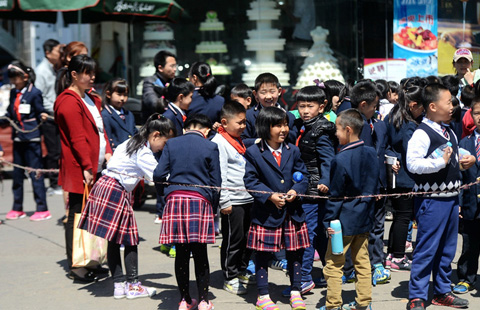CPC faces economic-ecological harmony challenges
(Xinhua) Updated: 2012-10-21 14:44Surging worries
Since the inception of the reform and opening-up drive over three decades ago, China has witnessed rapid economic growth, becoming the world's second largest economy in 2010.
But China's growth is over-dependent on resource consumption, marked by resource use inefficiencies and environmental ills. This creates worries about China's ability to sustain its development.
China tops the world in the amount of resources it consumes. Coal accounts for 70 percent of the gross energy output and consumption in China, according to statistics.
In North China's Shanxi Province, a major coal production base, the extraction of coal has already led to the damage of more than 6,000 square kms of forest and the erosion of another 6,000 square kms of land.
Half of the petroleum that China consumes now is imported. China's annual petroleum consumption in 2020, according to some experts, is expected to cross the 650 million ton mark. This is an amount beyond the limit tolerable by China's economy and environment.
The country sped up industrialization during the past 30 years, leading to fast CO2 emissions growth. Labeled as one of the world's largest sources of emissions, China is feeling international pressure.
In 2006, China for the first time listed emission reduction goals in its five-year national development plan (2006-2010), demanding the aggregate energy consumption per unit GDP drop around 20 percent from that of 2005.
The goal was accomplished. But to meet the emission limit, It was reported electricity supply to production firms in some regions was temporarily cut.
Meanwhile, there has been increased public anger over the environment in recent years, forcing some pollution-prone chemical and industry projects to be closed or relocated.
Environmental protection remained a crucial challenge for China in 2011-2015, as the country felt increasing pressure in pollution control and emission reduction internally and externally, according to Minister of Environmental Protection, Zhou Shengxian.
Long-term mission
Officials and experts said the ruling CPC has made greater and substantial efforts in environmental protection since 2007.
Resource-related enterprises in Huangshi contributed greatly to the country's economic growth. However, the development pattern that focused only on resource extraction produced serious ecological problems, according to Wang Jianming, secretary of the Huangshi city committee of the Communist Party of China.
"Promoting a conservation culture is an urgent matter. Huangshi still needs development, but a sustainable one," he said. The city has shut a number of small-size cement firms, paper mills, power plants and other pollution-prone firms over the past five years.
China is undergoing the transfer of industrial capacities from the country's developed coastal areas to the less-developed inlands. A city on the Yangtze River, Huangshi is an ideal place for many industrial projects.
Wang said the city became "picky" in selecting prospective industrial investments, putting "ecological benefits" before "economic benefits", and welcoming only environment-friendly projects.
But still there are officials in regions other than Huangshi who focused on rapid economic growth only and failed to pay enough attention to environmental protection.
The local government in the eastern city of Qidong in July canceled an industrial waste pipeline project hours after thousands of angry residents protested.
"Promoting a conservation culture is a major test for the ruling CPC at present and in the future," said Ma Zhejun, executive vice-president of the Party School of the CPC's Hubei Provincial Committee, urging for long-term efforts.
Experts expect that the CPC National Congress next month will further efforts to promote a conservation culture, and achieve harmony between economic development and environmental protection.
- Expert says big quake unlikely to hit nation soon
- Habit of reading in China expands with mobile tech
- Pollution poses threat to cities' water
- Man, 57, detained in courier beating captured on video
- Embryos growing in space a 'giant leap'
- 500 students sickened at school built on toxic site
- Expat database to meet talent demand, supply
- Mainland urges Taiwan to give fraud suspects 'punishment they deserve'
- China mulls lifting ban on online lottery sales this year
- Uber eyes smaller Chinese cities to take on home-grown Didi








